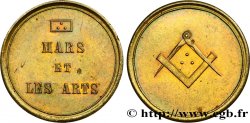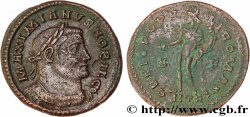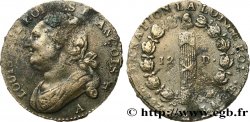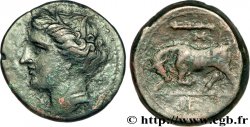fme_972032 - FRANC-MAÇONNERIE - PARIS BESANÇON, LA SINCÉRITÉ, LA PARFAITE UNION ET LA CONSTANTE AMITIÉ RÉUNIES
400.00 €
Cantidad
Añadir a su cesta

Tipo : BESANÇON, LA SINCÉRITÉ, LA PARFAITE UNION ET LA CONSTANTE AMITIÉ RÉUNIES
Fecha: 1845
Nombre del taller / ciudad: BESANÇON
Metal: plata
Diámetro: 127 mm
Eje de acuñación: 12 h.
Peso: 8,62 g.
Canto: lisse
Cuño: sans poinçon
Grado de rareza: R3
Comentarios sobre el estado de conservación:
Patine grise hétérogène avec des taches d’oxydation. Petite usure. Ruban en bel état
N° en los catálogos de referencia :
Anverso
Titulatura del anverso: S :. P :. U :. / ET / C.A. RÉUNIES / O :. BESANÇON.
Descripción del anverso: Étoile à cinq branches, posée sur un fond rayonnant. Inscriptions sur médaillon central .
Traducción del anverso: (Il meurt pour revivre).
Reverso
Descripción del reverso: Sur médaillon central triangle radiant avec oeil qui voit tout .
Comentario
Dimensions de l’étoile : 43*44 mm
Ruban vert bordé de lignes rouges (largeur : 40 mm).
Accompagné d’un ruban bleu pale avec macaron rouge (80 cm de long soit 160 cm - 106 mm de large)
Non répertorié et non photographié dans l’ouvrage de Marc Labouret. Manque au Labouret !
L'histoire de la franc-maçonnerie à Besançon débute à partir du XVIIIe siècle, lors de la création de la plus ancienne loge de la ville, la loge Sincérité. Son ancienneté, son influence sur la franc-maçonnerie au XVIIIe siècle et sa contribution à la survivance d’un système maçonnique particulier, le Rite écossais rectifié, en fait encore aujourd'hui une loge d'exception.
Elle ne sera pas la seule institution franc-maçonne de la ville ; en effet, au cours des siècles les loges Parfaite Union et Constante Amitié s'ajoutent à la loge Sincérité, avant que toutes ne fusionnent pour former la loge « Sincérité, Parfaite Union et Constante Amitié Réunies » (SPUCAR).
En 1786, les deux loges de la ville, loges Sincérité et Parfaite Union, fusionnent, et à la veille de la Révolution, on les présente comme les têtes pensantes de la Révolution, même si dans les faits les maçons bisontins sont partagés.
Après la Révolution, la loge bisontine Sincérité et Parfaite Union se retrouve en clandestinité parce que le gouvernement révolutionnaire les soupçonne de fomenter une opposition ; il faudra attendre 1800 pour qu'elle rouvre ses portes à Besançon.
Le seul événement notable de la première moitié du XIXe siècle est la fusion de la loge Sincérité et Parfaite Union avec la loge Constante Amitié, qui donne la loge Sincérité, Parfaite Union et Constante Amitié Réunies survenue en 1845. Pierre-Joseph Proudhon, un frère initié à Besançon, viendra mettre en lumière une pensée politique partagée par la plupart des obédiences : le socialisme utopique.
C’est dans cette loge qu’est initié, en 1847, Pierre Joseph Proudhon (1809-1865), socialiste révolutionnaire, père de l’anarchiste. A la question : Quels sont les devoirs envers Dieu ? Il fait la célèbre réponse : la guerre ! (cf. wikipedia).
Star dimensions: 43*44 mm Green ribbon bordered with red lines (width: 40 mm).
Accompanied by a pale blue ribbon with red macaroon (80 cm long or 160 cm - 106 mm wide) Not listed and not photographed in Marc Labouret's work. Missing from Labouret! The history of Freemasonry in Besançon begins in the 18th century, with the creation of the oldest lodge in the city, the Sincérité lodge.. Its antiquity, its influence on Freemasonry in the 18th century and its contribution to the survival of a particular Masonic system, the Rectified Scottish Rite, still make it an exceptional lodge today..
It will not be the only Freemason institution in the city; in fact, over the centuries the lodges Parfaite Union and Constante Amitié were added to the lodge Sincérité, before all merged to form the lodge \\\"Sincérité, Parfaite Union et Constante Amitié Réunies\\\" (SPUCAR).
In 1786, the two lodges of the town, the Sincérité and Parfaite Union lodges, merged, and on the eve of the Revolution, they were presented as the thinking heads of the Revolution, even if in fact the Besançon masons were divided.
After the Revolution, the Besançon lodge Sincérité et Parfaite Union went underground because the revolutionary government suspected them of fomenting opposition; it was not until 1800 that it reopened its doors in Besançon..
The only notable event of the first half of the 19th century was the merger of the Sincérité et Parfaite Union lodge with the Constante Amitié lodge, which gave rise to the Sincérité, Parfaite Union et Constante Amitié Réunies lodge, which occurred in 1845.. Pierre-Joseph Proudhon, a brother initiated in Besançon, will come to highlight a political thought shared by most obediences: utopian socialism.
It was in this lodge that Pierre Joseph Proudhon (1809-1865), revolutionary socialist, father of the anarchist, was initiated in 1847.. To the question: What are the duties towards God? He gives the famous answer: war! (cf.. Wikipedia)
Ruban vert bordé de lignes rouges (largeur : 40 mm).
Accompagné d’un ruban bleu pale avec macaron rouge (80 cm de long soit 160 cm - 106 mm de large)
Non répertorié et non photographié dans l’ouvrage de Marc Labouret. Manque au Labouret !
L'histoire de la franc-maçonnerie à Besançon débute à partir du XVIIIe siècle, lors de la création de la plus ancienne loge de la ville, la loge Sincérité. Son ancienneté, son influence sur la franc-maçonnerie au XVIIIe siècle et sa contribution à la survivance d’un système maçonnique particulier, le Rite écossais rectifié, en fait encore aujourd'hui une loge d'exception.
Elle ne sera pas la seule institution franc-maçonne de la ville ; en effet, au cours des siècles les loges Parfaite Union et Constante Amitié s'ajoutent à la loge Sincérité, avant que toutes ne fusionnent pour former la loge « Sincérité, Parfaite Union et Constante Amitié Réunies » (SPUCAR).
En 1786, les deux loges de la ville, loges Sincérité et Parfaite Union, fusionnent, et à la veille de la Révolution, on les présente comme les têtes pensantes de la Révolution, même si dans les faits les maçons bisontins sont partagés.
Après la Révolution, la loge bisontine Sincérité et Parfaite Union se retrouve en clandestinité parce que le gouvernement révolutionnaire les soupçonne de fomenter une opposition ; il faudra attendre 1800 pour qu'elle rouvre ses portes à Besançon.
Le seul événement notable de la première moitié du XIXe siècle est la fusion de la loge Sincérité et Parfaite Union avec la loge Constante Amitié, qui donne la loge Sincérité, Parfaite Union et Constante Amitié Réunies survenue en 1845. Pierre-Joseph Proudhon, un frère initié à Besançon, viendra mettre en lumière une pensée politique partagée par la plupart des obédiences : le socialisme utopique.
C’est dans cette loge qu’est initié, en 1847, Pierre Joseph Proudhon (1809-1865), socialiste révolutionnaire, père de l’anarchiste. A la question : Quels sont les devoirs envers Dieu ? Il fait la célèbre réponse : la guerre ! (cf. wikipedia).
Star dimensions: 43*44 mm Green ribbon bordered with red lines (width: 40 mm).
Accompanied by a pale blue ribbon with red macaroon (80 cm long or 160 cm - 106 mm wide) Not listed and not photographed in Marc Labouret's work. Missing from Labouret! The history of Freemasonry in Besançon begins in the 18th century, with the creation of the oldest lodge in the city, the Sincérité lodge.. Its antiquity, its influence on Freemasonry in the 18th century and its contribution to the survival of a particular Masonic system, the Rectified Scottish Rite, still make it an exceptional lodge today..
It will not be the only Freemason institution in the city; in fact, over the centuries the lodges Parfaite Union and Constante Amitié were added to the lodge Sincérité, before all merged to form the lodge \\\"Sincérité, Parfaite Union et Constante Amitié Réunies\\\" (SPUCAR).
In 1786, the two lodges of the town, the Sincérité and Parfaite Union lodges, merged, and on the eve of the Revolution, they were presented as the thinking heads of the Revolution, even if in fact the Besançon masons were divided.
After the Revolution, the Besançon lodge Sincérité et Parfaite Union went underground because the revolutionary government suspected them of fomenting opposition; it was not until 1800 that it reopened its doors in Besançon..
The only notable event of the first half of the 19th century was the merger of the Sincérité et Parfaite Union lodge with the Constante Amitié lodge, which gave rise to the Sincérité, Parfaite Union et Constante Amitié Réunies lodge, which occurred in 1845.. Pierre-Joseph Proudhon, a brother initiated in Besançon, will come to highlight a political thought shared by most obediences: utopian socialism.
It was in this lodge that Pierre Joseph Proudhon (1809-1865), revolutionary socialist, father of the anarchist, was initiated in 1847.. To the question: What are the duties towards God? He gives the famous answer: war! (cf.. Wikipedia)








 Informar de un error
Informar de un error Imprimir la página
Imprimir la página Comparte mi selección
Comparte mi selección Haz una pregunta
Haz una pregunta Consignar / vender
Consignar / vender
 Descriptivo
Descriptivo















